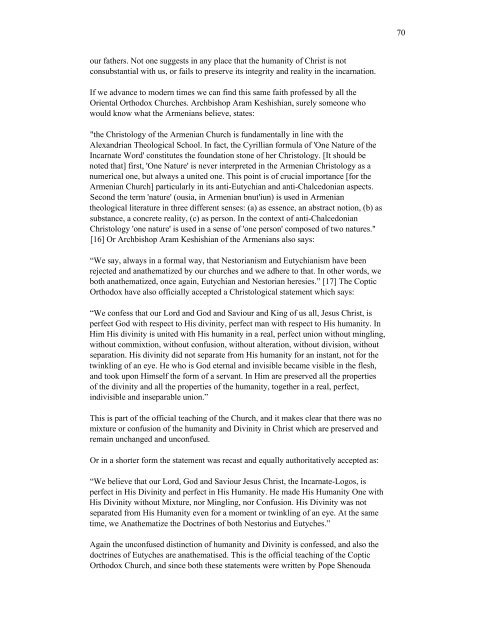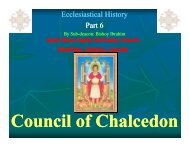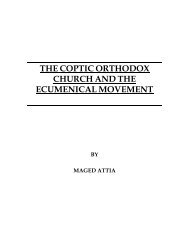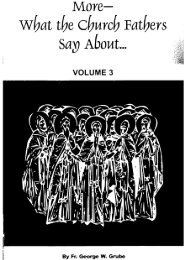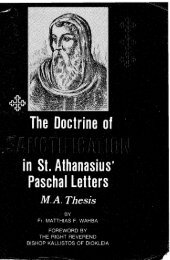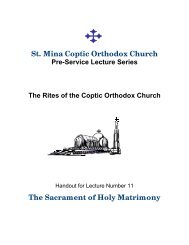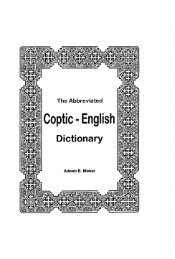Coptic interpretations of the Fourth Ecumenical Council - Saint Mina ...
Coptic interpretations of the Fourth Ecumenical Council - Saint Mina ...
Coptic interpretations of the Fourth Ecumenical Council - Saint Mina ...
Create successful ePaper yourself
Turn your PDF publications into a flip-book with our unique Google optimized e-Paper software.
our fa<strong>the</strong>rs. Not one suggests in any place that <strong>the</strong> humanity <strong>of</strong> Christ is not<br />
consubstantial with us, or fails to preserve its integrity and reality in <strong>the</strong> incarnation.<br />
If we advance to modern times we can find this same faith pr<strong>of</strong>essed by all <strong>the</strong><br />
Oriental Orthodox Churches. Archbishop Aram Keshishian, surely someone who<br />
would know what <strong>the</strong> Armenians believe, states:<br />
"<strong>the</strong> Christology <strong>of</strong> <strong>the</strong> Armenian Church is fundamentally in line with <strong>the</strong><br />
Alexandrian Theological School. In fact, <strong>the</strong> Cyrillian formula <strong>of</strong> 'One Nature <strong>of</strong> <strong>the</strong><br />
Incarnate Word' constitutes <strong>the</strong> foundation stone <strong>of</strong> her Christology. [It should be<br />
noted that] first, 'One Nature' is never interpreted in <strong>the</strong> Armenian Christology as a<br />
numerical one, but always a united one. This point is <strong>of</strong> crucial importance [for <strong>the</strong><br />
Armenian Church] particularly in its anti-Eutychian and anti-Chalcedonian aspects.<br />
Second <strong>the</strong> term 'nature' (ousia, in Armenian bnut'iun) is used in Armenian<br />
<strong>the</strong>ological literature in three different senses: (a) as essence, an abstract notion, (b) as<br />
substance, a concrete reality, (c) as person. In <strong>the</strong> context <strong>of</strong> anti-Chalcedonian<br />
Christology 'one nature' is used in a sense <strong>of</strong> 'one person' composed <strong>of</strong> two natures."<br />
[16] Or Archbishop Aram Keshishian <strong>of</strong> <strong>the</strong> Armenians also says:<br />
“We say, always in a formal way, that Nestorianism and Eutychianism have been<br />
rejected and ana<strong>the</strong>matized by our churches and we adhere to that. In o<strong>the</strong>r words, we<br />
both ana<strong>the</strong>matized, once again, Eutychian and Nestorian heresies.” [17] The <strong>Coptic</strong><br />
Orthodox have also <strong>of</strong>ficially accepted a Christological statement which says:<br />
“We confess that our Lord and God and Saviour and King <strong>of</strong> us all, Jesus Christ, is<br />
perfect God with respect to His divinity, perfect man with respect to His humanity. In<br />
Him His divinity is united with His humanity in a real, perfect union without mingling,<br />
without commixtion, without confusion, without alteration, without division, without<br />
separation. His divinity did not separate from His humanity for an instant, not for <strong>the</strong><br />
twinkling <strong>of</strong> an eye. He who is God eternal and invisible became visible in <strong>the</strong> flesh,<br />
and took upon Himself <strong>the</strong> form <strong>of</strong> a servant. In Him are preserved all <strong>the</strong> properties<br />
<strong>of</strong> <strong>the</strong> divinity and all <strong>the</strong> properties <strong>of</strong> <strong>the</strong> humanity, toge<strong>the</strong>r in a real, perfect,<br />
indivisible and inseparable union.”<br />
This is part <strong>of</strong> <strong>the</strong> <strong>of</strong>ficial teaching <strong>of</strong> <strong>the</strong> Church, and it makes clear that <strong>the</strong>re was no<br />
mixture or confusion <strong>of</strong> <strong>the</strong> humanity and Divinity in Christ which are preserved and<br />
remain unchanged and unconfused.<br />
Or in a shorter form <strong>the</strong> statement was recast and equally authoritatively accepted as:<br />
“We believe that our Lord, God and Saviour Jesus Christ, <strong>the</strong> Incarnate-Logos, is<br />
perfect in His Divinity and perfect in His Humanity. He made His Humanity One with<br />
His Divinity without Mixture, nor Mingling, nor Confusion. His Divinity was not<br />
separated from His Humanity even for a moment or twinkling <strong>of</strong> an eye. At <strong>the</strong> same<br />
time, we Ana<strong>the</strong>matize <strong>the</strong> Doctrines <strong>of</strong> both Nestorius and Eutyches.”<br />
Again <strong>the</strong> unconfused distinction <strong>of</strong> humanity and Divinity is confessed, and also <strong>the</strong><br />
doctrines <strong>of</strong> Eutyches are ana<strong>the</strong>matised. This is <strong>the</strong> <strong>of</strong>ficial teaching <strong>of</strong> <strong>the</strong> <strong>Coptic</strong><br />
Orthodox Church, and since both <strong>the</strong>se statements were written by Pope Shenouda<br />
70


